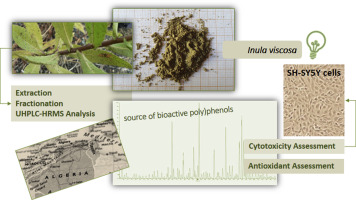当前位置:
X-MOL 学术
›
J. Food Drug Anal.
›
论文详情
Our official English website, www.x-mol.net, welcomes your
feedback! (Note: you will need to create a separate account there.)
A nutraceutical extract from Inula viscosa leaves: UHPLC-HR-MS/MS based polyphenol profile, and antioxidant and cytotoxic activities
Journal of Food and Drug Analysis ( IF 2.6 ) Pub Date : 2019-07-01 , DOI: 10.1016/j.jfda.2018.11.006 Nabila Brahmi-Chendouh 1, 2 , Simona Piccolella 1 , Giuseppina Crescente 1 , Francesca Pacifico 1 , Lila Boulekbache 2 , Sabrina Hamri-Zeghichi 2 , Salah Akkal 3 , Khodir Madani 2 , Severina Pacifico 1
Journal of Food and Drug Analysis ( IF 2.6 ) Pub Date : 2019-07-01 , DOI: 10.1016/j.jfda.2018.11.006 Nabila Brahmi-Chendouh 1, 2 , Simona Piccolella 1 , Giuseppina Crescente 1 , Francesca Pacifico 1 , Lila Boulekbache 2 , Sabrina Hamri-Zeghichi 2 , Salah Akkal 3 , Khodir Madani 2 , Severina Pacifico 1
Affiliation

|
Nowadays, advanced extraction techniques and highly sensitive metabolic profiling methods are effectively employed to get new information on plant chemical constituents. Among them wild medicinal plants or their parts, with large and ancient use in folk medicine, are investigated for their potential functional use and cultivation. In this context, Inula viscosa leaves engaged our attention. A simple experimental design, based on Soxhlet extraction and chromatographic fractionation, allowed us to obtain the investigated polyphenol fraction (IvE). UHPLC-HRMS analyses revealed shikimoyl depsides of caffeic acid and unusual dihydrobenzofuran lignans as main secondary metabolites. These compounds, together with cinchonain-type phenols, and hydroxycinnamoyl flavonol glycosides, are reported for the first time in inula. Overall, forty-three secondary metabolites were identified. The extract exerted a remarkable antiradical activity towards DPPH• and ABTS+•. Furthermore, it was able to inhibit cell viability and mitochondrial redox activity of neuroblastoma, hepatoblastoma and colon carcinoma cells, whereas it did not affect cell density of HaCaT cells immortalized human keratinocytes. As detected by the oxidant-sensing probe 2',7'-dichlorodihydrofluorescein diacetate, the inhibitory responses seemed to be related to IvE-induced increase of intracellular reactive oxygen species (ROS). The obtained results highlighted that inula leaves, nowadays even undervalued and unexplored, could be considered a renewable source of nutraceutical compounds.
中文翻译:

来自旋覆花叶的营养提取物:基于 UHPLC-HR-MS/MS 的多酚谱,以及抗氧化和细胞毒活性
如今,先进的提取技术和高灵敏度的代谢分析方法被有效地用于获取植物化学成分的新信息。其中野生药用植物或其部分在民间医学中具有大量和古老的用途,对其潜在的功能用途和栽培进行了调查。在这种情况下,旋覆花叶引起了我们的注意。基于索氏提取和色谱分离的简单实验设计使我们能够获得所研究的多酚部分 (IvE)。UHPLC-HRMS 分析显示,咖啡酸的莽草酰缩苷和不常见的二氢苯并呋喃木脂素是主要的次级代谢产物。这些化合物与金鸡宁型酚类和羟基肉桂酰黄酮醇苷一起,首次在菊苣中报道。全面的,鉴定了 43 种次生代谢物。该提取物对DPPH•和ABTS+•具有显着的抗自由基活性。此外,它能够抑制神经母细胞瘤、肝母细胞瘤和结肠癌细胞的细胞活力和线粒体氧化还原活性,而它不影响永生化人角质形成细胞的 HaCaT 细胞的细胞密度。正如氧化剂传感探针 2',7'-二氯二氢荧光素二乙酸酯所检测到的,抑制反应似乎与 IvE 诱导的细胞内活性氧 (ROS) 增加有关。获得的结果突出表明,如今即使被低估和未开发的旋覆叶也可以被视为营养保健化合物的可再生来源。它能够抑制神经母细胞瘤、肝母细胞瘤和结肠癌细胞的细胞活力和线粒体氧化还原活性,而它不影响永生化人角质形成细胞 HaCaT 细胞的细胞密度。正如氧化剂传感探针 2',7'-二氯二氢荧光素二乙酸酯所检测到的,抑制反应似乎与 IvE 诱导的细胞内活性氧 (ROS) 增加有关。获得的结果突出表明,如今即使被低估和未开发的旋覆叶也可以被视为营养保健化合物的可再生来源。它能够抑制神经母细胞瘤、肝母细胞瘤和结肠癌细胞的细胞活力和线粒体氧化还原活性,而它不影响永生化人角质形成细胞 HaCaT 细胞的细胞密度。正如氧化剂传感探针 2',7'-二氯二氢荧光素二乙酸酯所检测到的,抑制反应似乎与 IvE 诱导的细胞内活性氧 (ROS) 增加有关。获得的结果突出表明,如今即使被低估和未开发的旋覆叶也可以被视为营养保健化合物的可再生来源。-dichlorodihydrofluorescein diacetate,抑制反应似乎与 IvE 诱导的细胞内活性氧 (ROS) 增加有关。获得的结果突出表明,如今即使被低估和未开发的旋覆叶也可以被视为营养保健化合物的可再生来源。-dichlorodihydrofluorescein diacetate,抑制反应似乎与 IvE 诱导的细胞内活性氧 (ROS) 增加有关。获得的结果突出表明,如今即使被低估和未开发的旋覆叶也可以被视为营养保健化合物的可再生来源。
更新日期:2019-07-01
中文翻译:

来自旋覆花叶的营养提取物:基于 UHPLC-HR-MS/MS 的多酚谱,以及抗氧化和细胞毒活性
如今,先进的提取技术和高灵敏度的代谢分析方法被有效地用于获取植物化学成分的新信息。其中野生药用植物或其部分在民间医学中具有大量和古老的用途,对其潜在的功能用途和栽培进行了调查。在这种情况下,旋覆花叶引起了我们的注意。基于索氏提取和色谱分离的简单实验设计使我们能够获得所研究的多酚部分 (IvE)。UHPLC-HRMS 分析显示,咖啡酸的莽草酰缩苷和不常见的二氢苯并呋喃木脂素是主要的次级代谢产物。这些化合物与金鸡宁型酚类和羟基肉桂酰黄酮醇苷一起,首次在菊苣中报道。全面的,鉴定了 43 种次生代谢物。该提取物对DPPH•和ABTS+•具有显着的抗自由基活性。此外,它能够抑制神经母细胞瘤、肝母细胞瘤和结肠癌细胞的细胞活力和线粒体氧化还原活性,而它不影响永生化人角质形成细胞的 HaCaT 细胞的细胞密度。正如氧化剂传感探针 2',7'-二氯二氢荧光素二乙酸酯所检测到的,抑制反应似乎与 IvE 诱导的细胞内活性氧 (ROS) 增加有关。获得的结果突出表明,如今即使被低估和未开发的旋覆叶也可以被视为营养保健化合物的可再生来源。它能够抑制神经母细胞瘤、肝母细胞瘤和结肠癌细胞的细胞活力和线粒体氧化还原活性,而它不影响永生化人角质形成细胞 HaCaT 细胞的细胞密度。正如氧化剂传感探针 2',7'-二氯二氢荧光素二乙酸酯所检测到的,抑制反应似乎与 IvE 诱导的细胞内活性氧 (ROS) 增加有关。获得的结果突出表明,如今即使被低估和未开发的旋覆叶也可以被视为营养保健化合物的可再生来源。它能够抑制神经母细胞瘤、肝母细胞瘤和结肠癌细胞的细胞活力和线粒体氧化还原活性,而它不影响永生化人角质形成细胞 HaCaT 细胞的细胞密度。正如氧化剂传感探针 2',7'-二氯二氢荧光素二乙酸酯所检测到的,抑制反应似乎与 IvE 诱导的细胞内活性氧 (ROS) 增加有关。获得的结果突出表明,如今即使被低估和未开发的旋覆叶也可以被视为营养保健化合物的可再生来源。-dichlorodihydrofluorescein diacetate,抑制反应似乎与 IvE 诱导的细胞内活性氧 (ROS) 增加有关。获得的结果突出表明,如今即使被低估和未开发的旋覆叶也可以被视为营养保健化合物的可再生来源。-dichlorodihydrofluorescein diacetate,抑制反应似乎与 IvE 诱导的细胞内活性氧 (ROS) 增加有关。获得的结果突出表明,如今即使被低估和未开发的旋覆叶也可以被视为营养保健化合物的可再生来源。











































 京公网安备 11010802027423号
京公网安备 11010802027423号